run flat Acura Integra 2000 Hatchback Owner's Manual
[x] Cancel search | Manufacturer: ACURA, Model Year: 2000, Model line: Integra, Model: Acura Integra 2000Pages: 279, PDF Size: 3.57 MB
Page 132 of 279
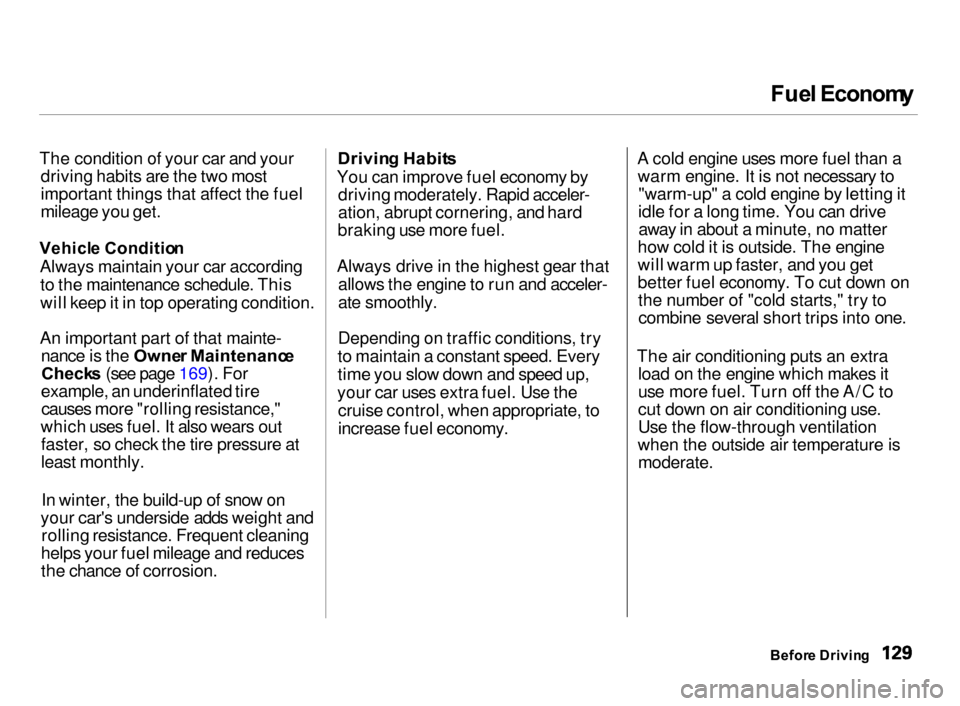
Fue
l Econom y
The condition of your car and your driving habits are the two most
important things that affect the fuel
mileage you get.
Vehicl e Conditio n
Always maintain your car according to the maintenance schedule. This
will keep it in top operating condition.
An important part of that mainte- nance is the Owne r Maintenanc e
Check s (see page 169). For
example, an underinflated tire causes more "rolling resistance,"
which uses fuel. It also wears out faster, so check the tire pressure at
least monthly.
In winter, the build-up of snow on
your car's underside adds weight and rolling resistance. Frequent cleaning
helps your fuel mileage and reduces
the chance of corrosion. Drivin
g Habit s
You can improve fuel economy by driving moderately. Rapid acceler-
ation, abrupt cornering, and hard
braking use more fuel.
Always drive in the highest gear that allows the engine to run and acceler-
ate smoothly.
Depending on traffic conditions, try
to maintain a constant speed. Every
time you slow down and speed up,
your car uses extra fuel. Use the cruise control, when appropriate, to
increase fuel economy. A cold engine uses more fuel than a
warm engine. It is not necessary to "warm-up" a cold engine by letting it
idle for a long time. You can drive away in about a minute, no matter
how cold it is outside. The engine
will warm up faster, and you get
better fuel economy. To cut down on the number of "cold starts," try tocombine several short trips into one.
The air conditioning puts an extra load on the engine which makes it
use more fuel. Turn off the A/C to
cut down on air conditioning use.
Use the flow-through ventilation
when the outside air temperature is
moderate.
Before Drivin g
Page 201 of 279
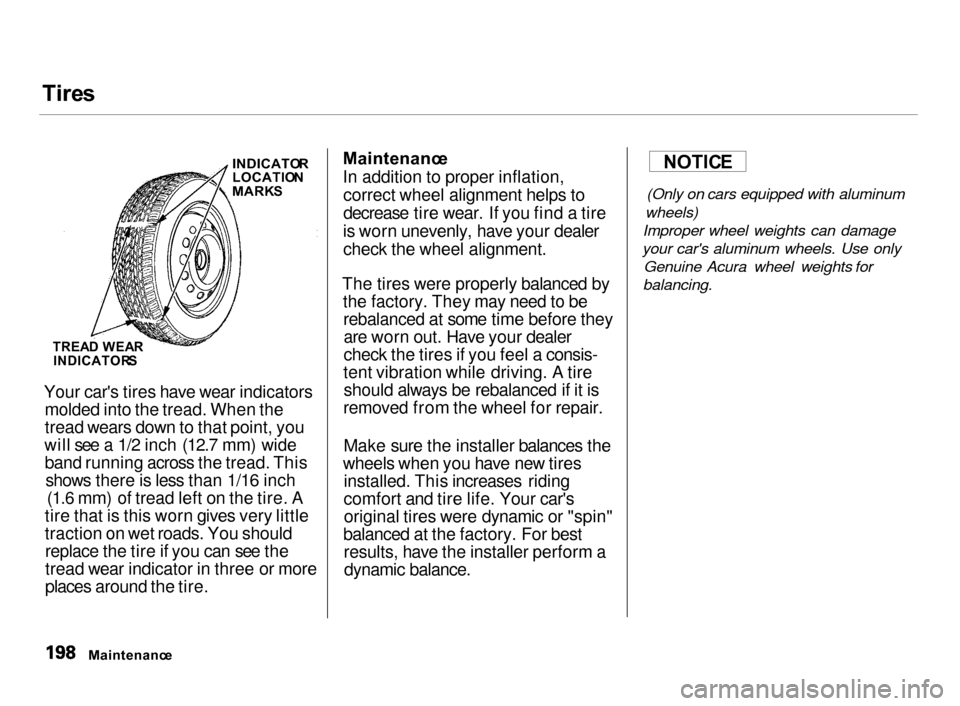
Tire
s
Your car's tires have wear indicators molded into the tread. When the
tread wears down to that point, you
will see a 1/2 inch (12.7 mm) wide band running across the tread. This shows there is less than 1/16 inch (1.6 mm) of tread left on the tire. A
tire that is this worn gives very little
traction on wet roads. You should replace the tire if you can see the
tread wear indicator in three or more
places around the tire. Maintenanc
e
In addition to proper inflation, correct wheel alignment helps to
decrease tire wear. If you find a tire
is worn unevenly, have your dealer check the wheel alignment.
The tires were properly balanced by the factory. They may need to berebalanced at some time before theyare worn out. Have your dealer
check the tires if you feel a consis-
tent vibration while driving. A tire should always be rebalanced if it is
removed from the wheel for repair.
Make sure the installer balances the
wheels when you have new tires installed. This increases riding
comfort and tire life. Your car'soriginal tires were dynamic or "spin"
balanced at the factory. For best results, have the installer perform adynamic balance.
(Only on cars equipped with aluminum
wheels)
Improper wheel weights can damage
your car's aluminum wheels. Use only Genuine Acura wheel weights for
balancing.
Maintenanc e
NOTIC
E
INDICATO R
LOCATIO N
MARK S
TREA D WEA R
INDICATOR S
Page 232 of 279
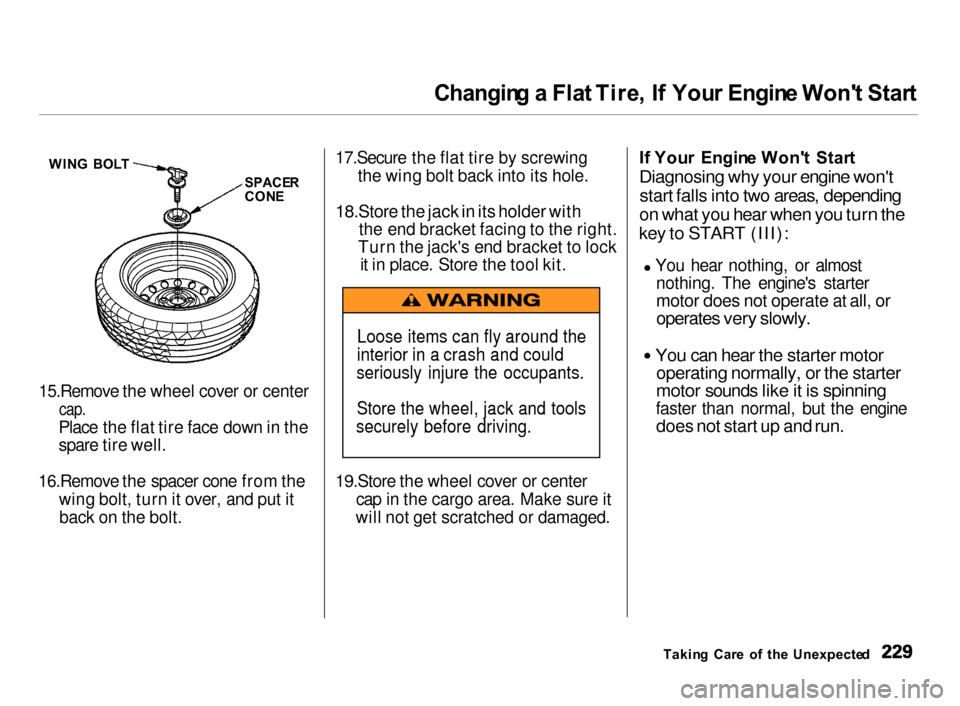
Changin
g a Fla t Tire , I f You r Engin e Won' t Star t
15.Remove the wheel cover or center
cap.
Place the flat tire face down in the
spare tire well.
16.Remove the spacer cone from the
wing bolt, turn it over, and put it back on the bolt.
17.Secure the flat tire by screwing
the wing bolt back into its hole.
18.Store the jack in its holder with
the end bracket facing to the right.
Turn the jack's end bracket to lock i t in place. Store the tool kit.
19.Store the wheel cover or center
cap in the cargo area. Make sure it
will not get scratched or damaged. I
f You r Engin e Won' t Star t
Diagnosing why your engine won't
start falls into two areas, depending
on what you hear when you turn the
key to START (III):
You hear nothing, or almostnothing. The engine's starter
motor does not operate at all, or
operates very slowly.
You can hear the starter motor
operating normally, or the starter
motor sounds like it is spinning
faster than normal, but the engine
does not start up and run.
Takin g Car e o f th e Unexpecte d
Loose items can fly around the
interior in a crash and could
seriously injure the occupants.
Store the wheel, jack and tools
securely before driving.
WIN
G BOL T
SPACER
CON E
Page 272 of 279
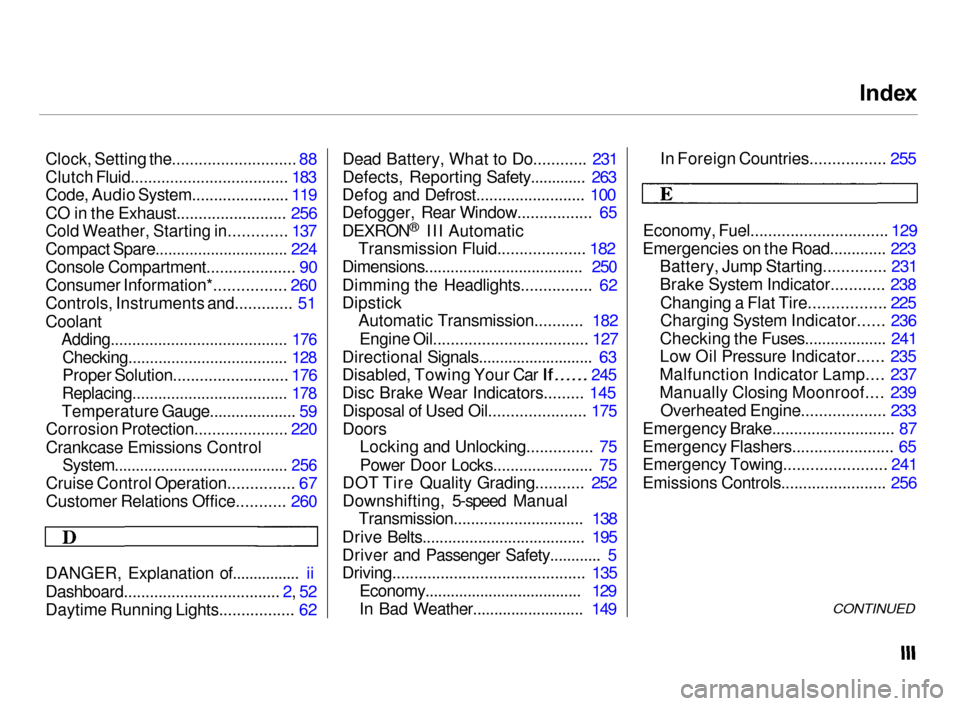
Inde
x
Clock, Setting the............................ 88
Clutch Fluid.................................... 183
Code, Audio System...................... 119
CO in the Exhaust......................... 256
Cold Weather, Starting in............. 137
Compact Spare............................... 224
Console Compartment.................... 90
Consumer Information*................ 260
Controls, Instruments and............. 51
Coolant
Adding......................................... 176
Checking..................................... 128
Proper Solution.......................... 176
Replacing.................................... 178
Temperature Gauge.................... 59
Corrosion Protection..................... 220
Crankcase Emissions Control
System......................................... 256
Cruise Control Operation............... 67
Customer Relations Office........... 260
DANGER, Explanation of................
ii
Dashboard.................................... 2, 52
Daytime Running Lights................. 62 Dead Battery, What to Do............ 231
Defects, Reporting Safety............. 263
Defog and Defrost......................... 100
Defogger, Rear Window................. 65
DEXRON ®
III Automatic
Transmission Fluid.................... 182
Dimensions..................................... 250
Dimming the Headlights................ 62
Dipstick Automatic Transmission........... 182
Engine Oil................................... 127
Directional Signals........................... 63
Disabled, Towing Your Car
If......
245
Disc Brake Wear Indicators......... 145 Disposal of Used Oil...................... 175
Doors Locking and Unlocking............... 75
Power Door Locks....................... 75
DOT Tire Quality Grading........... 252
Downshifting, 5-speed Manual Transmission.............................. 138
Drive Belts...................................... 195
Driver and Passenger Safety............ 5
Driving............................................ 135 Economy..................................... 129
In Bad Weather.......................... 149 In Foreign Countries................. 255
Economy, Fuel............................... 129
Emergencies on the Road............. 223 Battery, Jump Starting.............. 231
Brake System Indicator............ 238
Changing a Flat Tire................. 225
Charging System Indicator...... 236
Checking the Fuses................... 241
Low Oil Pressure Indicator...... 235
Malfunction Indicator Lamp.... 237
Manually Closing Moonroof.... 239 Overheated Engine................... 233
Emergency Brake............................ 87
Emergency Flashers....................... 65
Emergency Towing....................... 241
Emissions Controls........................ 256
CONTINUED
Page 274 of 279
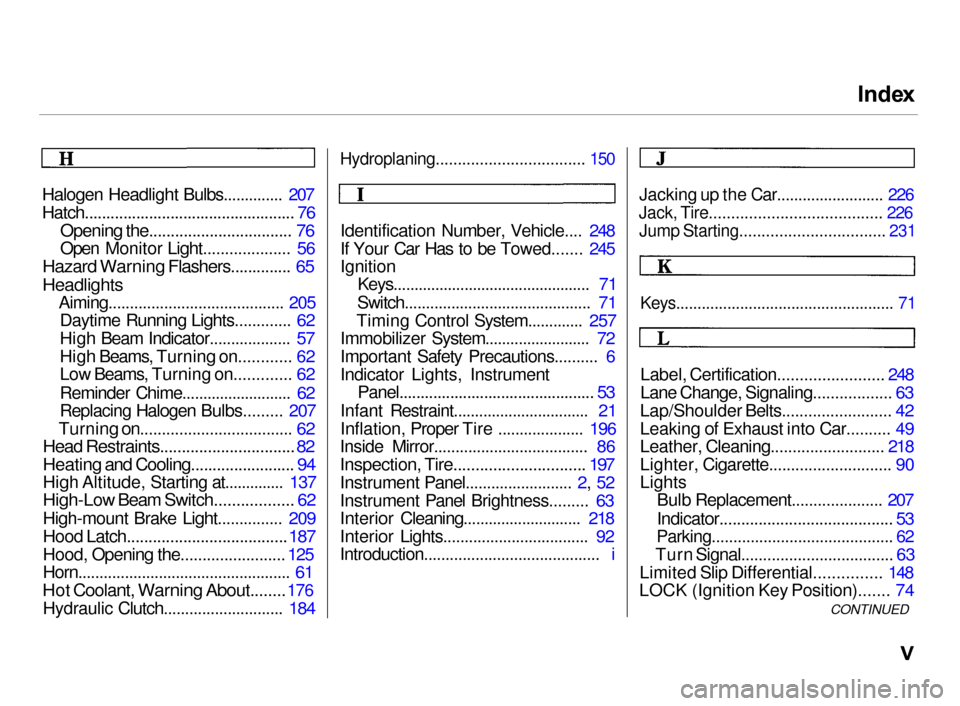
Inde
x
Halogen Headlight Bulbs.............. 207
Hatch................................................. 76
Opening the................................. 76
Open Monitor Light.................... 56
Hazard Warning Flashers.............. 65
Headlights
Aiming......................................... 205Daytime Running Lights............. 62
High Beam Indicator................... 57
High Beams, Turning on............ 62
Low Beams, Turning on............. 62
Reminder Chime.......................... 62
Replacing Halogen Bulbs......... 207
Turning on................................... 62
Head Restraints...............................
82
Heating and Cooling........................ 94
High Altitude, Starting at.............. 137
High-Low Beam Switch.................. 62
High-mount Brake Light............... 209
Hood Latch.....................................
187
Hood, Opening the........................
125
Horn..................................................
61
Hot Coolant, Warning About........
176
Hydraulic Clutch............................ 184
Hydroplaning.................................. 150
Identification Number, Vehicle.... 248
If Your Car Has to be Towed....... 245
Ignition Keys............................................... 71
Switch............................................ 71
Timing Control System............. 257
Immobilizer System......................... 72
Important Safety Precautions.......... 6
Indicator Lights, Instrument
Panel.............................................. 53
Infant Restraint................................ 21
Inflation, Proper Tire .................... 196
Inside Mirror.................................... 86
Inspection, Tire.............................. 197
Instrument Panel......................... 2, 52
Instrument Panel Brightness......... 63
Interior Cleaning............................ 218
Interior Lights.................................. 92
Introduction......................................... i
Jacking up the Car......................... 226
Jack, Tire....................................... 226
Jump Starting................................. 231
Keys................................................... 71
Label, Certification........................ 248
Lane Change, Signaling.................. 63
Lap/Shoulder Belts......................... 42
Leaking of Exhaust into Car.......... 49
Leather, Cleaning.......................... 218
Lighter, Cigarette............................ 90
Lights Bulb Replacement..................... 207
Indicator........................................ 53
Parking.......................................... 62
Turn Signal................................... 63
Limited Slip Differential............... 148
LOCK (Ignition Key Position)....... 74
CONTINUED